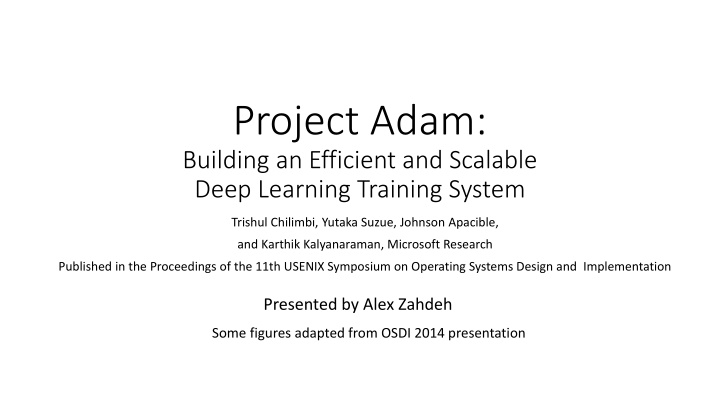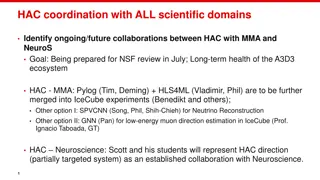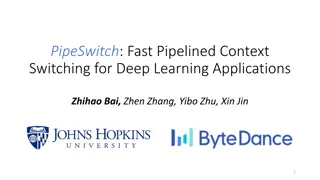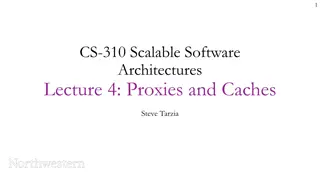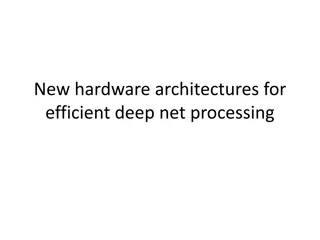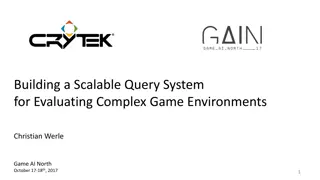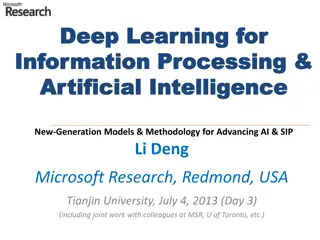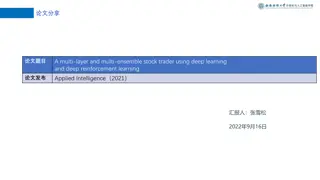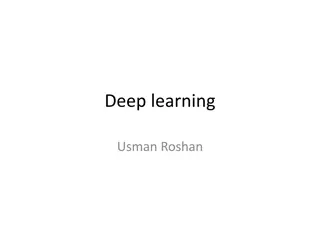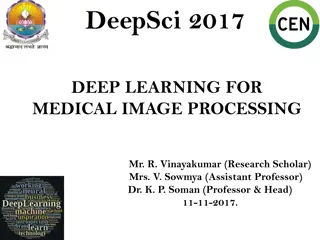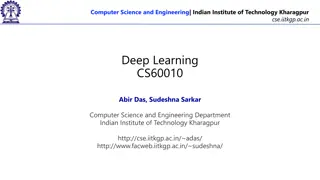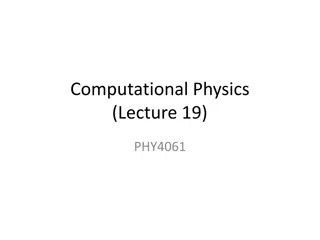Building an Efficient and Scalable Deep Learning System
In this study, the focus is on Project Adam, aiming to create an efficient and scalable deep learning training system. The research delves into the challenges faced in deep learning, highlighting the need for high computational power while emphasizing improvements in accuracy with increased data and model size. Various aspects of neural networks, convolutional neural networks, and neural network training are explored. The project aims to optimize computation and communication through system co-design for enhanced performance and scalability.
Download Presentation

Please find below an Image/Link to download the presentation.
The content on the website is provided AS IS for your information and personal use only. It may not be sold, licensed, or shared on other websites without obtaining consent from the author.If you encounter any issues during the download, it is possible that the publisher has removed the file from their server.
You are allowed to download the files provided on this website for personal or commercial use, subject to the condition that they are used lawfully. All files are the property of their respective owners.
The content on the website is provided AS IS for your information and personal use only. It may not be sold, licensed, or shared on other websites without obtaining consent from the author.
E N D
Presentation Transcript
Project Adam: Building an Efficient and Scalable Deep Learning Training System Trishul Chilimbi, Yutaka Suzue, Johnson Apacible, and Karthik Kalyanaraman, Microsoft Research Published in the Proceedings of the 11th USENIX Symposium on Operating Systems Design and Implementation Presented by Alex Zahdeh Some figures adapted from OSDI 2014 presentation
Deep Learning Objective Function Humans Prediction Data Deep Learning
Problem with Deep Learning Current computational needs on the order of petaFLOPS!
Neural Networks http://neuralnetworksanddeeplearning.com/images/tikz11.png
Convolutional Neural Networks http://colah.github.io/posts/2014-07-Conv-Nets-Modular/img/Conv2-9x5-Conv2Conv2.png
Convolutional Neural Networks with Max Pooling http://colah.github.io/posts/2014-07-Conv-Nets-Modular/img/Conv-9-Conv2Max2Conv2.png
Neural Network Training (with Stochastic Gradient Descent) Inputs processed one at a time in random order with three steps: 1. Feed-forward evaluation 2. Back propagation 3. Height updates
Project Adam Optimizing and balancing both computation and communication for this application through whole system co- design Achieving high performance and scalability by exploiting the ability of machine learning training to tolerate inconsistencies well Demonstrating that system efficiency, scaling, and asynchrony all contribute to improvements in trained model accuracy
Adam System Architecture Fast Data Serving Model Training Global Parameter Server
Fast Data Serving Large quantities of data needed (10-100TBs) Data requires transformation to prevent over-fit Small set of machines configured separately to perform transformations and serve data Data servers pre-cache images using nearly all of system memory as a cache Model training machines fetch data in advance in batches in the background
Model Training Models partitioned vertically to reduce cross machine communication
Multi Threaded Training Multiple threads on a single machine Different images assigned to threads that share model weights Per-thread training context stores activations and weight update values Training context pre-allocated to avoid heap locks NUMA Aware
Fast Weight Updates Weights updated locally without locks Race condition permitted Weight updates are commutative and associative Deep neural networks are resilient to small amounts of noise Important for good scaling
Reducing Memory Copies Pass pointers rather than copying data for local communication Custom network library for non local communication Exploit knowledge of the static model partitioning to optimize communication Reference counting to ensure safety under asynchronous network IO
Memory System Optimizations Partition so that model layers fit in L3 cache Optimize computation for cache locality Forward and Back propagation have different row-major/column- major preferences Custom assembly kernels to appropriately pack a block of data so that vector units are fully utilized
Mitigating the Impact of Slow Machines Allow threads to process multiple images in parallel Use a dataflow framework to trigger progress on individual images based on arrival of data from remote machines At end of epoch, only wait for 75% of the model replicas to complete Arrived at through empirical observation No impact on accuracy
Parameter Server Communication Two protocols for communicating parameter weight updates 1. Locally compute and accumulate weight updates and periodically send them to the server Works well for convolutional layers since the volume of weights is low due to weight sharing 2. Send the activation and error gradient vectors to the parameter servers so that weight updates can be computed there Needed for fully connected layers due to the volume of weights. This reduces traffic volume from M*N to K*(M+N)
Global Parameter Server Rate of updates too high for a conventional key value store Model parameters divided into 1 MB shards Improves spatial locality of update processing Shards hashed into storage buckets distributed equally among parameter servers Helps with load balancing
Global Parameter Server Throughput Optimizations Takes advantage of processor vector instructions Processing is NUMA aware Lock free data structures Speeds up IO processing Lock free memory allocation Buffers allocated from pools of specified size (powers of 2 from 4KB to 32MB)
Delayed Persistence Parameter storage modelled as write back cache Dirty chunks flushed asynchronously Potential data loss tolerable by Deep Neural Networks due to their inherent resilience to noise Updates can be recovered if needed by retraining the model Allows for compression of writes due to additive nature of weight updates Store the sum, not the summands Can fold in many updates before flushing to storage
Fault Tolerance Three copies of each parameter shard One primary, two secondaries Parameter Servers controlled by a set of controller machines Controller machines form a Paxos cluster Controller stores the mapping of roles to parameter servers Clients contact controller to determine request routing Controller hands out bucket assignments Lease to primary, primary lease information to secondaries
Fault Tolerance Primary accepts requests for parameter updates for all chunks in a bucket Primary replicates changes to secondaries using 2PC Secondaries check lease information before committing Parameter server send heartbeats to secondaries In absence of a heartbeat, a secondary intitiates a role change proposal Controller elects a secondary as a primary
Communication Isolation Update processing and durability decoupled Separate 10Gb NICs are used for each of the paths Maximize bandwidth, minimize interference
Evaluation Visual Object Recognition Benchmarks System Hardware Baseline Performance and Accuracy System Scaling and Accuracy
Visual Object Recognition Benchmarks MNIST digit recognition http://cs.nyu.edu/~roweis/data/mnist_train1.jpg
Visual Object Recognition Benchmarks ImageNet 22k Image Classification American Foxhound English Foxhound http://www.exoticdogs.com/breeds/english-fh/4.jpg http://www.juvomi.de/hunde/bilder/m/FOXEN01M.jpg
System Hardware 120 HP Proliant servers Each server has an Intel Xeon E5-2450L processor 16 core, 1.8GHZ Each server has 98GB of main memory, two 10Gb NICs, one 1 Gb NIC 90 model training machines, 20 parameter servers, 10 image servers 3 racks each of 40 servers, connected by IBM G8264 switches
Baseline Performance and Accuracy Single model training machine, single parameter server. Small model on MNIST digit classification task
System Scaling and Accuracy Scaling with Model Workers Scaling with Model Replicas Trained Model Accuracy
Summary Pros World record accuracy on large scale benchmarks Highly optimized and scalable Fault tolerant Cons Thoroughly optimized for Deep Neural Networks; Unclear if it can be applied to other models
